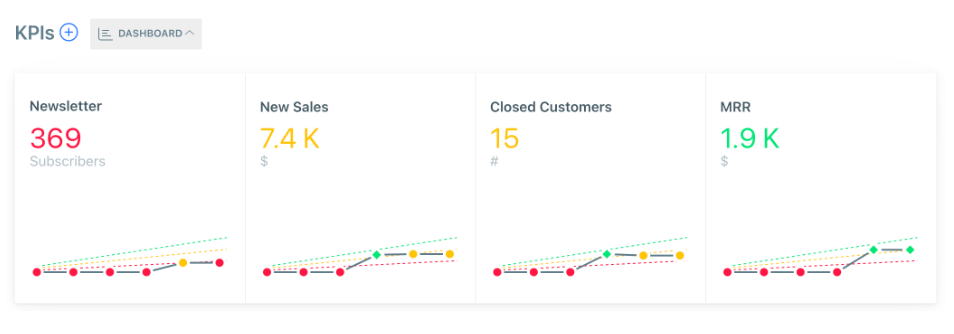Every modern, goal-driven leader needs to balance macro-level and micro-level strategies. On the one hand, you need to create the vision, ensure it is communicated, and incorporate them into growth strategies – by creating Company-level Objectives and OKRs.
On the other hand, you need to keep track of the indicators of the health of the company using Key Performance Indicators (KPIs). Understanding the difference between an OKR vs KPI is a critical success factor for modern leaders who are goal-driven.
Working with leaders to help transform their strategies and goal-setting approach, we have discovered many insights. In this article, we will discuss how you can differentiate between an OKR and KPI by answering some of the questions that most leaders ask.
👉 Consider these examples to see the difference between an OKR vs KPI. Or learn from a success story, and know how to implement OKRs and KPIs using tools and software programs.
Or better yet, see the difference in a real-world application
10 Questions Goal-Driven Leaders Must Ask to Differentiate an OKR vs KPI
1. What to consider as a leadership team when creating OKRs for the first time (having already created annual KPI targets)?
While you may be using KPIs to measure performance, what about those Big Hairy Audacious Goals (BHAG) that drive success? Do you know if your annual KPIs are on track? Even if you have annual KPIs you need to measure if KPI is on target every month and quarter.
To set, track, and measure aspirational goals, the OKR framework has proven to be a successful methodology. It helps to understand – Why are we doing this? What are the improvement areas? and What must we do to make it better?
When creating OKRs for the first time, some of the aspects that leadership teams need to consider include:
- Start your goal-setting process by using your company’s mission and vision statements as a guiding framework. Take a moment to see the difference between a company-level OKR vs KPI targets:
| Performance Metrics (KPIs) | Company-Level Objectives and Key Results (OKRs) |
| – MRR (Monthly Recurring Revenue) – ARR (Annual Recurring Revenue) – CAC (Customer Acquisition Cost) – CLTV (Customer Lifetime Value) | – Increase Revenue (KR Example – Achieve or exceed $2 million revenue by Q4) – Utilize Resources Effectively and Implement Cost – Control Measures (KR Example – Implement at least 2 solutions to control and reduce costs in 3 cost-intensive areas in Q4) – Widen Market Presence (KR Example – Generate $250,000 in new sales from the new market every month) – Acquisition Strategy for Growth (Example KR – Reach $500,000 in new acquisitions by next quarter) 👉 Check out more CEO OKR Examples |
- Break down your company-level strategy into quarterly Objectives.
- Create OKRs and publish them to make them visible to everyone. Before finalizing high-level OKRs, it is important to communicate them and ensure that everyone provides feedback.
- Discuss and finalize the quarterly OKRs with all teams to ensure that strategy and execution are aligned and to maintain focus on activities with high priority.
- Use OKR tools such as spreadsheets or an OKR software program, to automatically set, track, and measure your OKRs.
💡 Keep in mind that, to align teams to a common goal and create a meaningful Company OKR, you must ideally set at least 1 Objective and 3 to 7 Key Results in a quarter.
2. How do you identify the issues for the Company level Objective, and who does that?
How to create OKRs and identify improvement areas? Typically, strategy is the input for company objectives. Your company mission and vision can serve as a great way to understand what your objectives should be.
When differentiating between an OKR vs KPI, keep in mind that KPIs can be used to determine your company objectives and can also serve as an input when creating OKRs for teams.
KPIs measure against targets and it tells you how it was done (in the past) and if you are on track. For example, A KPI could measure a growing target like revenue or a horizontal target such as customer satisfaction.
While KPIs tell if you are on or off track, it does not show you how to improve. OKRs drive KPIs forward and provide a measure of what success looks like – it tells you how you can improve.
Company-level objectives are typically created by the leadership team. Given that leaders would be able to provide the direction that the company needs to take through the quarter. From there, the Company OKRs can then be used by different teams to align their Team OKRs – making the whole company aligned to a common goal.
3. What is the value of tracking OKRs & KPIs together? Why should it be done?
OKRs and KPIs are complementary and must not be considered as competing concepts. To create and deliver strategies, it not a “OKR vs KPI” premise, you need both OKRs and KPIs.
The OKR methodology helps identify improvement and growth areas, while KPIs help measure and monitor business performance.
💡 KPIs measure performance and help you understand if you are on track to meet your targets.
If you are not on track, creating OKRs can help you focus on what to improve.
– Objectives focus on a problem statement
– Key Results include outcome measurements
– Initiatives include execution to drive OKRs forward
The main reason for using KPIs is to understand the potential to succeed. However, if used in isolation without considering strategies and objectives, it serves only as a performance metric and fails to provide insights into improvement areas to achieve success. By tracking both OKRs and KPIs, you can manage output-driven initiatives to deliver outcome-centric results.
👉 Which is better OKR or KPI? Find out how they complement and not compete with each other.
4. Are OKRs more suitable for mature organizations? Can small companies use KPIs as a substitute for OKRs?
The OKR methodology is used by tech giants such as Google, Amazon, and LinkedIn. We’ve observed that many leaders of small businesses wonder whether the OKR framework is suitable for them and if they should continue using regular business metrics (like KPIs) to measure performance.
Irrespective of the size of the company, having overarching goals is a great way to drive growth. When early-stage startups or small businesses are considering the OKR vs KPI conundrum, they need to know what data they have to measure. KPIs can be created by analyzing past performance and setting future targets.
OKRs can be created from the strategy instead of KPIs and can be used at different stages of a business. It depends on what you can and want to measure.
There is no magic formula that can support your choice between an OKR vs KPI. What works at Google and LinkedIn may not be suitable for your company. But, you can learn from the best practices they use and customize the approach to fit your business needs.
👉 Get to know how you can Contextualize Google OKRs and Make Goal-Setting a Part of Your Company’s DNA
5. How do Key Results (KRs) reflect the confidence in achieving KPI targets?
Key Results focus on outcomes and measure the progress toward achieving the Objective. KPIs are performance metrics and focus on whether targets are met. KRs and KPIs are interdependent – KRs provide clarity about the desired outcomes and roles and responsibilities to achieve those outcomes – which include achieving KPIs.
Good Key Results reflect confidence in achieving KPIs because they are set to be measurable, actionable, and time-bound. Every Objective that your team sets must ideally have between 2 to 5 Key Results, with 3 KRs being the optimal number.
💡 Keep in mind that you should ideally have no more than 3 KPIs and 10 Key Results for a single Objective, or it could get overwhelming. With fewer OKRs you can gain better focus and achieve greater results.
6. Should KPIs be annual and company-level OKRs be quarterly and why?
Another aspect that differentiates an OKR vs KPI is the cadence at which it is set. KPIs are typically set annually and used to gauge performance in the long term. High-level KPIs look at business performance as a whole (such as achieving $1M in annual recurring revenue this year). However, annual KPIs are often forgotten and not translated to team goals and do not add accountability.
OKRs driven by leadership teams set the direction for the whole company quarter on quarter. Teams can relate to the company vision and mission and can create their objectives based on the strategy for every quarter.
For OKRs to be successful following an annual cadence does not work. The reason why OKRs are set quarterly is that it gives a good cadence and focus period – most business models use 90 days as a cycle. Setting quarterly objectives and key results allow for continuous engagement to solve problems and improve. It gives the chance to celebrate small wins.
💡 Keep in mind that setting quarterly OKRs offers four learning cycles in the year and setting them beyond a quarter defeats the purpose.
Choosing a shorter OKR cycle is also not feasible. Most teams take longer than 2 to 3 weeks to write good OKRs. So if you choose a 6-weekly OKR cycle, it could result in poor results. Instead, keeping a quarterly cadence and conducting retrospectives at the end of the quarter is a good way to stay on track.

You would have to be an OKR champion to write good OKRs within 2 to 3 weeks. Find out if you are one!
👉 Why do you need an OKR Champion in your team? Here are 10 reasons
7. What if it is difficult to create measurable Key Results, should they be set as KPIs?
When setting KRs, if you do not know the values you start your progress from 0 and then change it as the week or quarter progresses. However, before you tackle the OKR vs KPI dilemma, you need to have data and identify metrics that you want to track.
If you do not have past data, make an educated estimate about the metric and identify how you are going to measure it. This value can be changed as you progress toward your goal.
💡 It is important to set a value to drive thinking toward a target and create KRs that make you think.
While Key Results have to be measurable, keep in mind that they are outputs, but outcomes. Output delivered (published 10 articles) is not a Key Result, outcomes are (improved blog engagement rate by 10%).
👉 Make your KRs meaningfully measurable, and know the difference between outcomes and output.

8. If a team’s KPIs are on track, should they create OKRs for the quarter? Can KPIs influence or even become OKRs?
Theoretically, if a team’s KPIs are on track, there is no reason to have an OKR for the quarter for that KPI as no improvement is required. However, when a KPI target is on track, there could be other areas of improvement that the team or company needs to focus on.
When a company grows, tracking KPIs does not serve as a satisfactory measurement. The main reason is that KPIs help track output and do not inspire or encourage the team to think of what can be improved. By creating specific OKRs, you can keep the focus on what matters most and those results that will drive growth.
KPIs are inputs and can influence your OKRs.
For instance, if your KPI is to achieve 80% customer satisfaction, it is measuring a business-as-usual target. What happens if the performance decreases and falls below target?
Setting an objective that says the team needs to increase customer satisfaction does not define how it can be done to improve performance. Instead, an impactful OKR would be to improve response rates from customers by the end of the quarter.
👉 Check out these pointers that can help you transition from KPIs to OKRs and level up your goal-setting process.
9. Should KPIs be set, tracked, and measured in an OKR tool?
While your KPIs should not be a part of the OKR strategy, in the real world they are inexplicably linked. Most companies use KPIs to create OKRs and therefore they need to be measured together in the same OKR platform.
KPIs help teams measure progress toward achieving an Objective. To ensure that they are aligned it is best to set, track, and measure them in one platform. Also, making KPIs and OKRs visible to everyone can encourage initiatives to drive progress toward achieving specific objectives.
👉 If you want to know how you can align KPIs, OKRs, and Projects and auto-update your KPIs on Weekdone’s OKR platform, watch these videos:
10. Can you visualize the status of both KPIs and OKRs in one dashboard?
Adding KPIs to your reporting dashboard can provide context to your OKRs. Providing visibility of the health metrics and growth targets, allows you to stay on track and focus on important areas that need improvements.
In the Weekdone OKR platform, you can import the numeric values of your KPIs and KRs and they can be updated automatically from Google Sheets. In this way, you can save time on updating data manually and ensure that the status of your progress is always up to date.
👉 Learn more about how you can visualize the status of KPIs

Combine the Power of OKRs and KPIs
Ultimately, combining OKRs and KPIs empowers you to drive growth and improvements while keeping an eye on the performance of your business. When all metrics are aligned – from long-term, high-level targets, quarterly objectives, and weekly plans, to daily initiatives – it can help you create a business environment that is innovative, productive, and profitable.
“It takes a village” to work together and achieve a common goal. And if not implemented the right way, the results can be counterproductive.

While planning goals can be challenging, what’s more difficult is tracking and implementing OKRs correctly – and achieving them. That’s why you need to adopt OKR best practices and use the right tools. To set strategic OKRs and get step-by-step guidance, consult with our OKR experts.
If you have already set your OKRs and need to implement or refine them, take a test run of our user-friendly platform.

